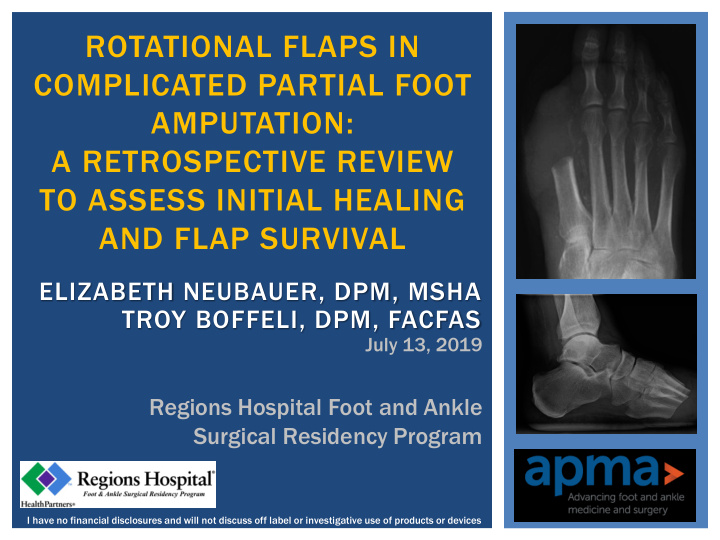



ROTATIONAL FLAPS IN COMPLICATED PARTIAL FOOT AMPUTATION: A RETROSPECTIVE REVIEW TO ASSESS INITIAL HEALING AND FLAP SURVIVAL ELIZABETH NEUBAUER, DPM, MSHA TROY BOFFELI, DPM, FACFAS July 13, 2019 Regions Hospital Foot and Ankle Surgical Residency Program 1 I have no financial disclosures and will not discuss off label or investigative use of products or devices
VALUE OF ROTATIONAL FLAPS Large plantar wound deficits lead to residual wound or extensive loss of foot function with amputation Rotational flaps allow a more desirable level of amputation with complete wound closure HealthPartners/ Regions Hospital Foot & Ankle Surg ery
LITERATURE REVIEW Challenging micro-environment 1 Tissue ischemia Immune impairment Biomechanical derangement Peripheral neuropathy Non-healing nature of diabetes-related plantar neuropathic ulcers does not preclude successful incorporation of rotational flaps 2 1. Rodrigues, Plast Reconstr Glob Open 2017 2. Boffeli & Peterson, JFAS 2013 HealthPartners/ Regions Hospital Foot & Ankle Surg ery
ADVANTAGES Full-thickness flap is the most successful approach for plantar foot wounds due to mobility, sensation, and tissue thickness 3 Immediate coverage of osseous structures and soft tissue defects 4 Prompt healing by primary intention 4 Limb preservation: avoid or delay proximal amputation 4 Improve delivery of antibiotic therapy 4 3. Park et al, JFAS 1997 4. Boffeli & Peterson, JFAS 2016 HealthPartners/ Regions Hospital Foot & Ankle Surg ery
FLAP PROTOCOL Complicated wounds requiring nontraditional closure Delay flap until osteomyelitis but intervene before abscess or necrosis Plan for flap failure: incisions that don’t preclude future amputation PMMA beads when necessary Raise full-thickness flaps Limited-touch or no-touch technique with skin hooks Hug contours of bone to minimize neurovascular compromise HealthPartners/ Regions Hospital Foot & Ankle Surg ery
FIRST RAY AMPUTATION FLAP Boffeli & Peterson, JFAS 2013 HealthPartners/ Regions Hospital Foot & Ankle Surg ery
FIFTH RAY AMPUTATION FLAP Boffeli & Peterson, JFAS 2013 HealthPartners/ Regions Hospital Foot & Ankle Surg ery
TMA WITH LPAA ROTATIONAL FLAP Boffeli & Waverly, JFAS 2015 HealthPartners/ Regions Hospital Foot & Ankle Surg ery
V T TMA FLAP Medial Plantar Artery Angiosome + Lateral Plantar Artery Angiosome Boffeli & Waverly, JFAS 2015 HealthPartners/ Regions Hospital Foot & Ankle Surg ery
STATEMENT OF PURPOSE Assess initial flap healing & intermediate term survival of common pedal flaps when incorporated into partial foot amputation Assess prevalence & influence of common comorbidities Hypothesis: A high percentage of rotational flaps heal successfully despite comorbid conditions HealthPartners/ Regions Hospital 10 Foot & Ankle Surg ery
RESEARCH METHODOLOGY Level 3 retrospective Consecutive cases identified by CPT billing history 1 st ray (20) 5 th ray (26) Medial/lateral plantar artery (37) Single surgeon (TJB) 2011 – 2015 Minimum 2-year follow- up to assess longevity Exclusion criteria: digital flap, trauma etiology, tumor etiology, deceased, insufficient follow-up HealthPartners/ Regions Hospital Foot & Ankle Surg ery
PRELIMINARY RESULTS Flap ap Ty Type Freq equen ency 103 total flaps were reviewed 1 st ray 20 83 flaps met inclusion criteria 5 th ray 26 71 patients (M = 55, F = 16) MPA TMA 13 Age: 62.5 ± 1.2 years (range 38-94) LPA TMA 16 77 feet (L = 46, R = 31) MPA & LPA 8 HealthPartners/ Regions Hospital Foot & Ankle Surg ery
COMORBID CONDITIONS Com omor orbid C Con ondition on Prevalence ce Diabetes 86.7% Peripheral Neuropathy 95.2% Osteomyelitis 95.2% Obese 50.6% Peripheral Vascular Disease 47.0% Overweight 25.3% Gangrene 33.7% Heterotopic Ossification 45.8% Charcot 4.8% HealthPartners/ Regions Hospital 13 Foot & Ankle Surg ery
INITIAL FLAP HEALING RESULTS 54/83 (65.1%) were completely healed by 6 weeks 15 more healed after 6 weeks without further surgery 6 more healed following local revision surgery Healin ling T g Tim ime for an overall success rate 25 of 75/83 (90.4%) ents 20 of Patien 8/83 (9.6%) did not heal 15 er o 6 required more 10 Number proximal amputation 5 0 2 passed due to 3 4 5 6 7 8 9 10 11 12 13 14 20 >20 unrelated conditions Week eeks Average time to healing after revision = 12.5 weeks HealthPartners/ Regions Hospital Foot & Ankle Surg ery
LONGEVITY OF FLAP 21/82 (25.3%) required more proximal amputation within 2 years TMA (11) BKA (8) AKA (2) HealthPartners/ Regions Hospital 15 Foot & Ankle Surg ery
CONCLUSIONS High percentage of rotational flaps heal successfully despite comorbid conditions 69/82 (83.1%) healed uneventfully 75/82 (90.3%) healed with revision Diabetes and peripheral neuropathy were the most prevalent comorbid conditions Immediate flap coverage for complicated amputations avoids excessive costs associated with chronic bone exposure, long-term Vac therapy, and recurrent osteomyelitis. HealthPartners/ Regions Hospital Foot & Ankle Surg ery
THANK YOU! elizabeth.f.neubauer@healthpartners.com Boffeli TJ, Collier RC. Near Total Calcanectomy with Rotational Flap Closure of Large Decubitus Heel Ulcerations Complicated by Calcaneal Osteomyelitis. J Foot Ankle Surg. 51:135-140, 2012. Boffeli TJ, Peterson MC. Rotational Flap Closure of First and Fifth Metatarsal Head Plantar Ulcers: Adjunctive Procedure When Performing First or Fifth Ray Amputation. J Foot Ankle Surg. 52 (2013):263-270. Boffeli TJ, Waverly BJ. Medial and Lateral Plantar Artery Angiosome Rotational Flaps for Transmetatarsal and Lisfranc Amputation in Patients With Compromised Plantar Tissue. J Foot Ankle Surg. 55(2016)351-361. Park EY, Elliott ED, Giacopelli JA, Granoff DP, Salm RJ. The Use of Transpositional Skin Flaps in Closing Plantar Defects: A Case Report. J Foot Ankle Surg. 36:315- 321, 1997. Rodriguez Collazo ER, Rathbone CR, Barnes BR. A Retrospective Look at Integrating a Novel Regenerative Medicine Approach in Plastic Limb Reconstruction. Plastic and Reconstructive Surgery – Global Open. 2017;5:e1214 . HealthPartners/ Regions Hospital 17 Foot & Ankle Surg ery
Recommend
More recommend